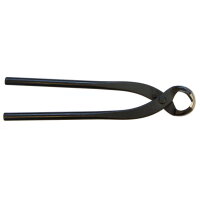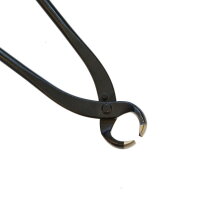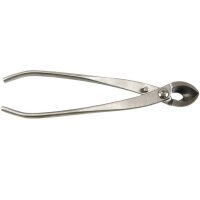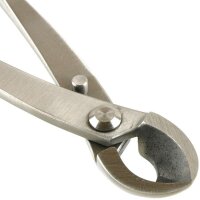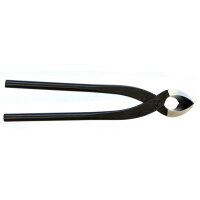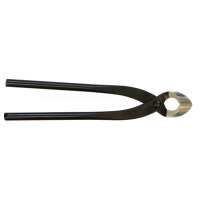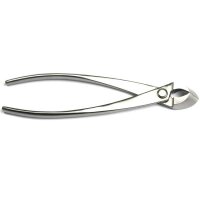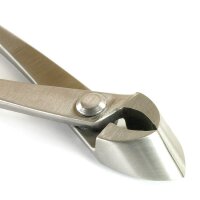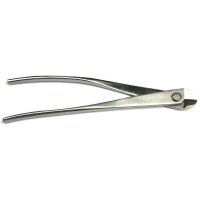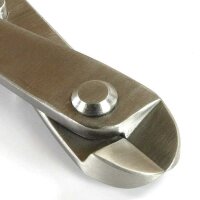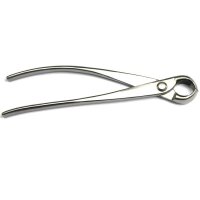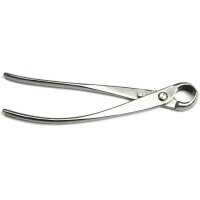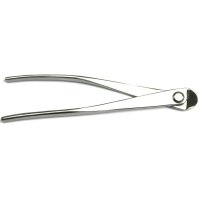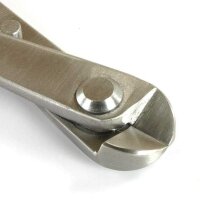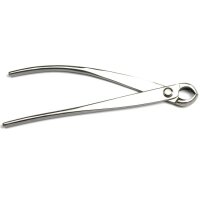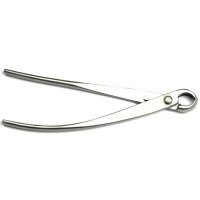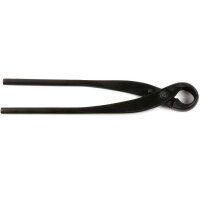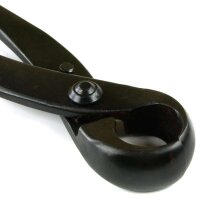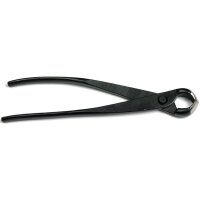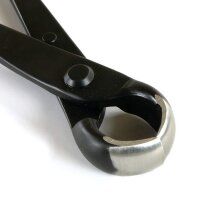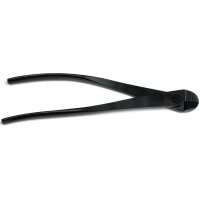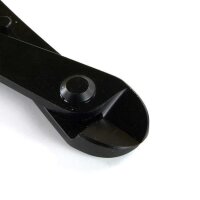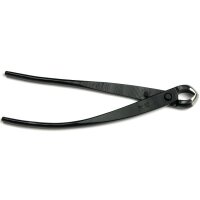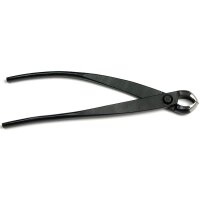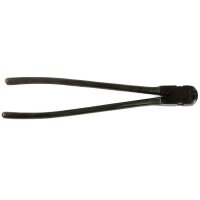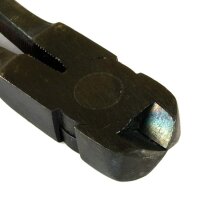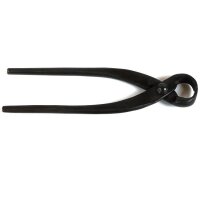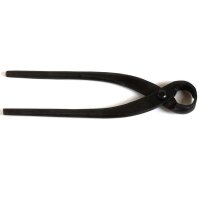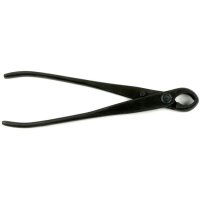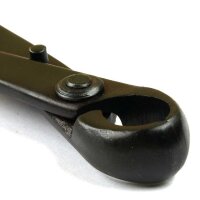Bonsai cutter and pliers
Bonsai cutter and pliers are among the most important tools for bonsai design. They are used to remove stronger shoots, branches and roots from the bonsai. They are also needed for cutting bonsai wire or shaping dead wood.
Depending on the purpose, the bonsai cutter are divided into: concave cutter, knob cutter (round head cutter), wire cutter, Jin pliers, root cutter und trunk splitter. Information on how to use the different bonsai cutter can be found at the end of this page.
Concave cutter
Bonsai concave cutter are essential tools. It can be used to easily remove both living and dead branches. Concave cutter are difficult to replace with other tools. The reason lies in the structure of the cutting edges. The concave shaped jaws of concave pliers leave an elongated wound when cutting. This heals very quickly and scarring is minimal.

Depending on the design, maintenance condition and size of the concave cutter, even thick branches can be cut. A diameter of 3-4 cm is no problem for sharp concave cutters from 27 cm in length.
What types of concave cutters are available for bonsai ?
- Black: Most commonly purchased. The black coating is applied before sanding. Black or not says little about the quality of the concave cutters.
- Stainless steel: Looks elegant. But it's not necessarily better than black concave pliers.
- Round head: halfway between normal concave pliers with a straight cutting edge and knob cutter. The cut image is a little rounder. The round concave pliers cut a little deeper and can withstand significantly more force. This means it can hardly be bent open.
What should you pay attention to when using concave cutter for bonsai ?
- Buy the right size. The small concave pliers under 20cm are only made for very small trees. Most bonsai enthusiasts need concave cutter in the 21-27cm range.
- Always cut lengthways along the trunk or branch with concave cutter, not across. Fewer sap tracts are injured and the wound then grows together much faster and, above all, better.
- After purchasing, do not cut branches that are too thick. Especially with the small cutter, the cutting edges can be bent open with excessive force. Try to get a feel for your concave pliers. A feeling for which branch can be handled by which concave cutter.
- A very clean cut is possible with sharp concave cutter. Such wounds on the bonsai heal quickly and well. With high-quality concave cutter, even precise recutting is easy.
- We recommend tool oil to care for the concave pliers (including stainless versions). If they are cleaned and oiled after work, the cutter remain smooth and there is no risk of rust spots.
What size ?
- under 20cm: These concave cutter are suitable for fine work on a bonsai tree up to 30cm high
- 20-22cm: Standard concave cutter for cutting bonsai. This can be used to remove branches up to around 1.5cm in diameter
- 26-36cm: For bonsai >50cm height. Thicker branches up to 3cm in diameter can be cut
- 36cm: For large garden bonsai, the extra large concave cutter are well suited as an alternative to the saw
You should only buy the small concave cutter if you want to work on really small trees. Frequently used concave cutter have lengths between 21 and 27cm (described as medium and large in the shop).
Wound healing
With the correct use of sharp concave cutter, the wounds heal very well, even after larger branches have been removed. A good example can be seen below in the right picture (Left: On an elm bonsai, Japanese elm, Ulmus japonica scars 3 and 5 years after removal of 3cm thick branches, Right: Wound on a lime bonsai, 2 years after cutting. Soon the wound will be closed)
Knob cutter
Bonsai knob cutter are good for removing thicker branches. In contrast to concave cutter, the jaws of knob cutter are round. They are often also referred to as round head cutter.
The round jaws allow branches to be cut perpendicular to the trunk. A slightly inwardly curved cut remains, which also heals well. Thanks to their jaw shape, knob cutter do not bend so easily like a concave cutter. This means that thicker branches can be removed with knob cutter of the same size.
Knob cutter are also good to use when creating a jin (dead, bark-stripped branch) by scoring the live bark before peeling it off.
The comments on the versions (black, stainless steel) and the sizes essentially correspond to the comments on the concave cutter (see above).
Wire cutters
Wire cutter for bonsai are very helpful when wiring bonsai - but essential when unwire a bonsai (removing the bonsai wire from the branch). After bonsai scissors and concave cutter, wire cutter are one of the most important tools.
When unwiring a bonsai, the wire should not be unwound. The bark could be damaged. Due to the special design of the cutting edges of wire cutter, the bonsai wire can be cut smoothly into small pieces on the branch. There is hardly any risk of bark damage being visible for a long time.
Wire cutter less than 20cm long can be used for aluminum wire up to 2mm thickness. We recommend larger wire cutter.
After a bonsai has been wired it continues to grow. That is also desired. This is the only way new wood is formed, the wired branch thickens and can later hold the new position even without wire.

But: the thicker the branch becomes, the more the wire presses in. It leaves clearly visible traces.
As long as the wire only presses lightly into the bark, there is no problem. In most tree species (e.g. larch, pine), the pressure points disappear quickly after dewiring. Only with bonsai with very smooth bark (e.g. beech) should you be very careful when pressing. Wire traces are visible for a very long time on smooth bark.
If a wire is pressing in more strongly, then it is time to remove it. For this purpose, wire cutters for bonsai are used.
Thanks to the special design of these wire cutters, the bark is not damaged when cutting - a big advantage compared to, for example, side cutters from the hardware store.
Jin pliers
Jin pliers for bonsai are mainly used when shaping dead wood to remove the bark and strip off the wood fibers in strips. Jin pliers are also helpful for pre-bending thicker bonsai wire.
Root cutter
As the name suggests, root cutter for bonsai are primarily used to remove thicker roots.
Trunk splitter
Trunk splitter for bonsai are used primarily when designing dead wood to create jin (dead branches) and shari (dead trunk sections) by splitting the wood.
